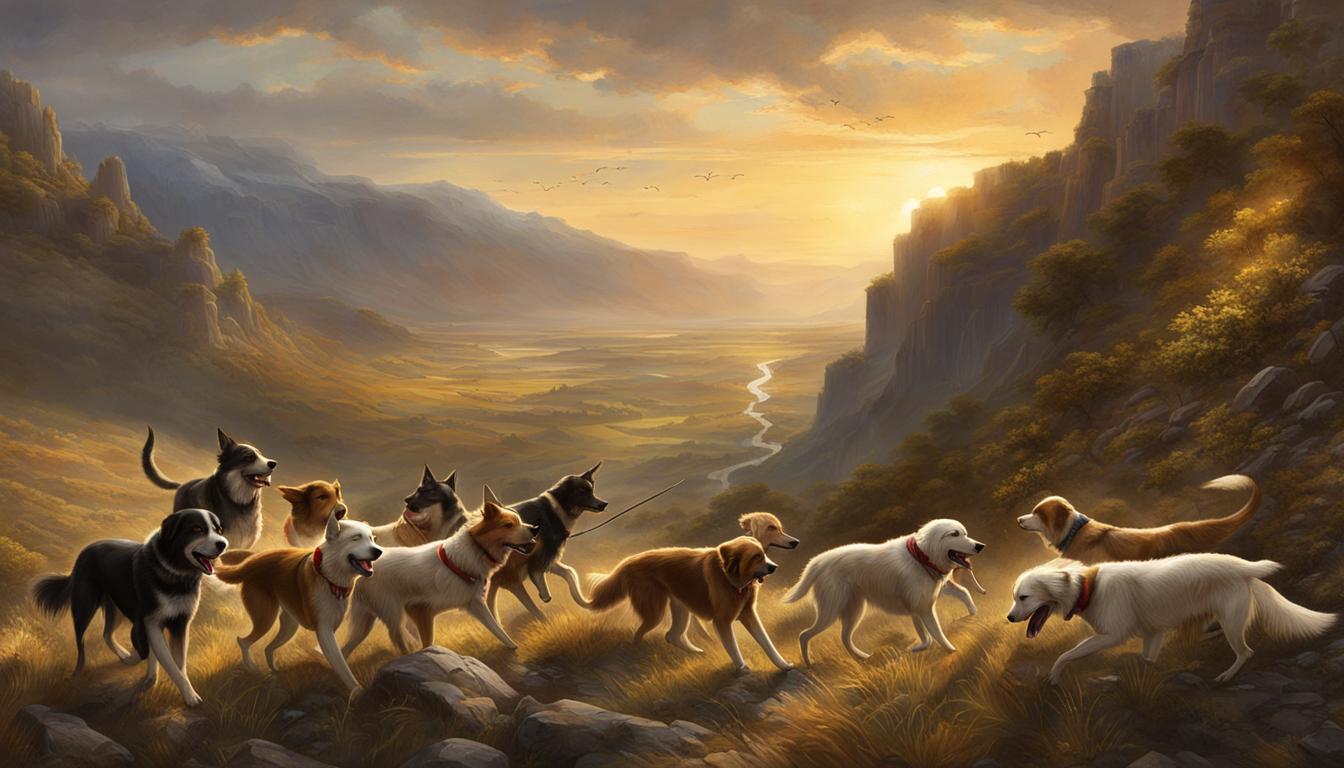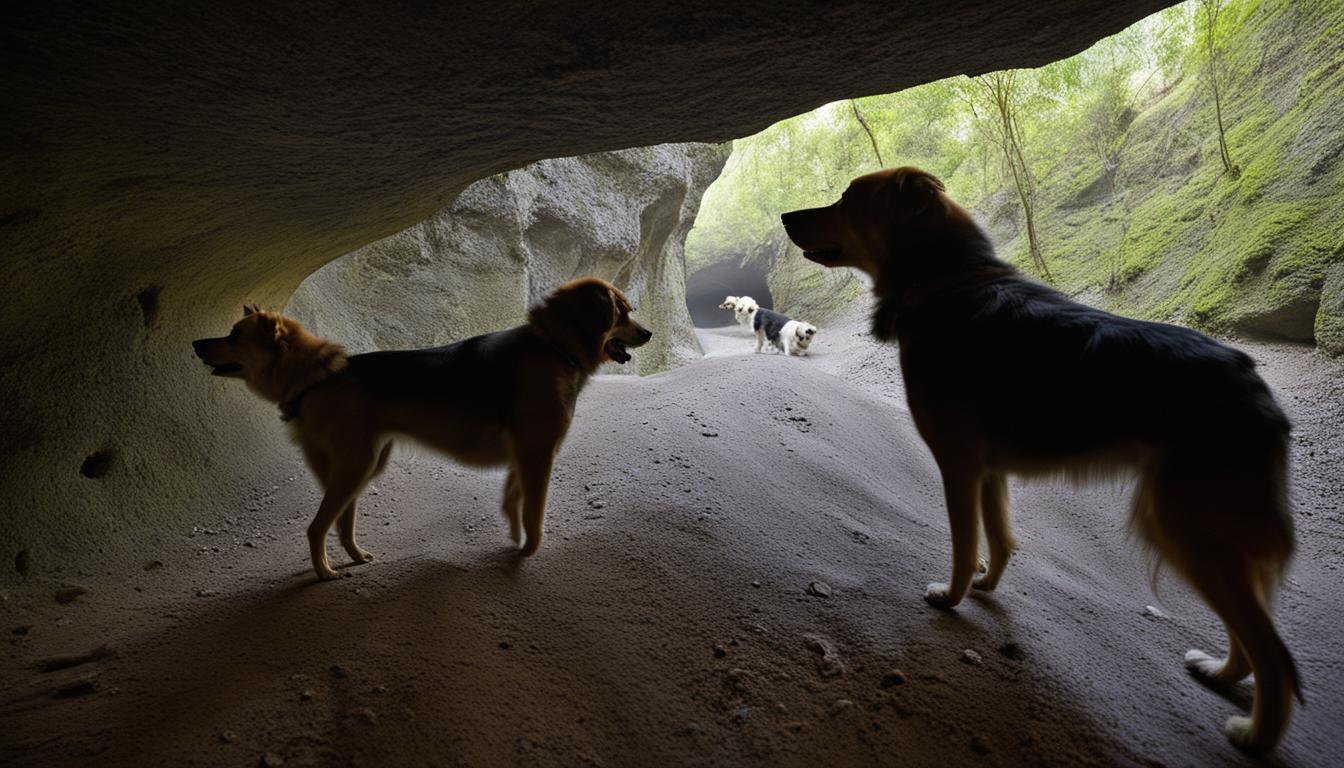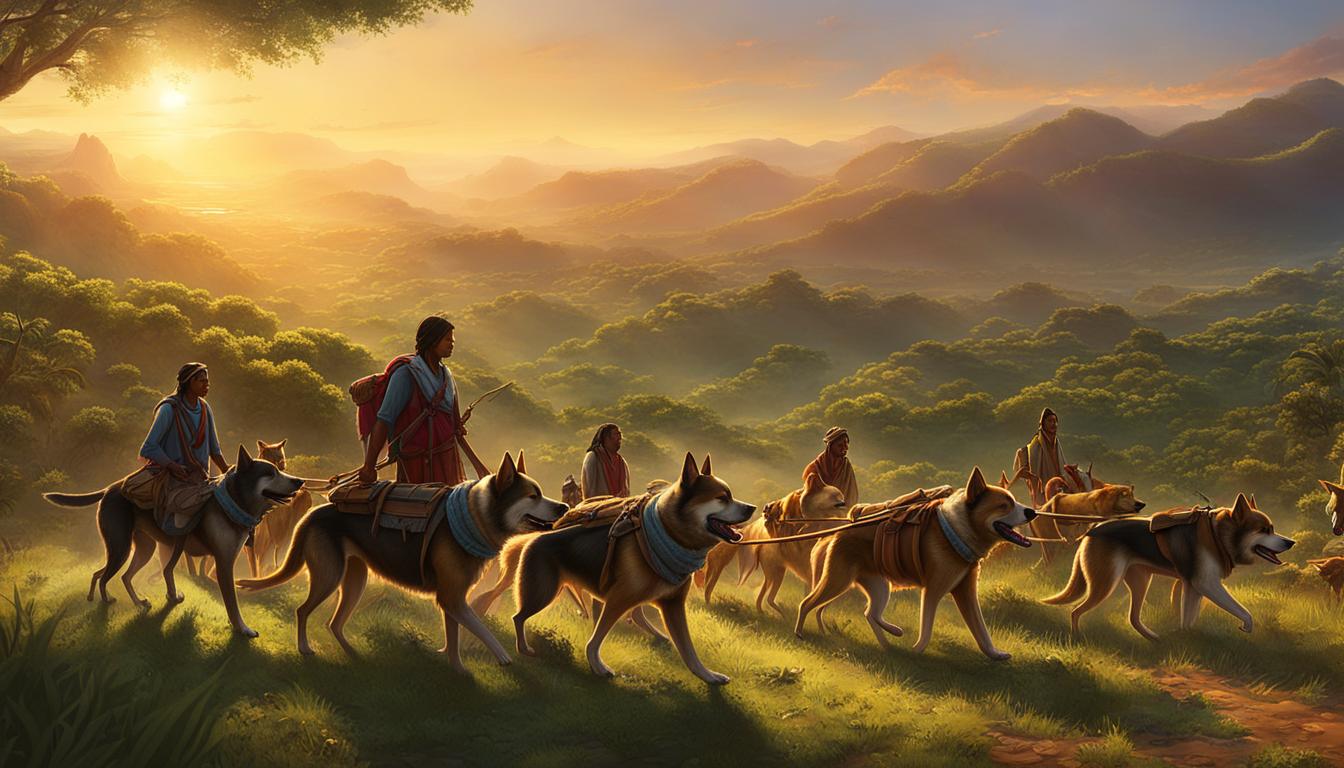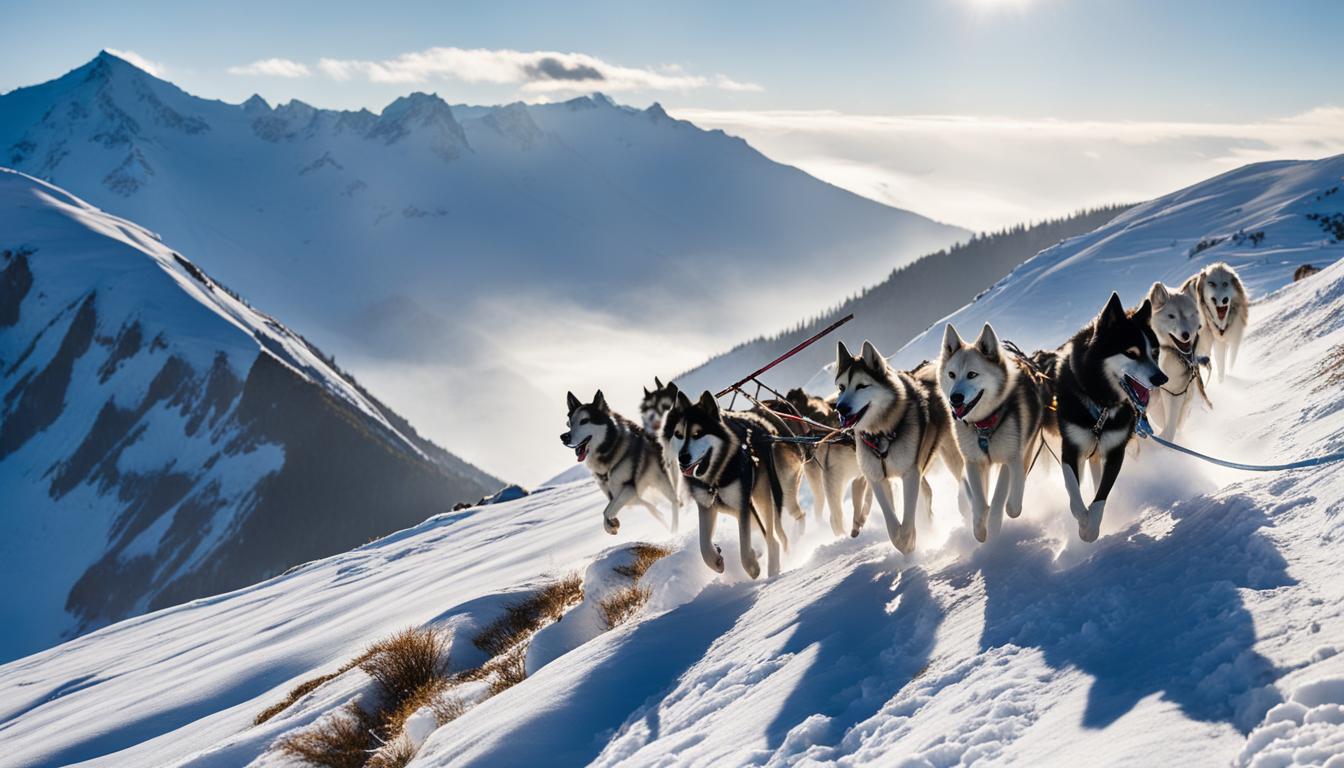Welcome to our fascinating journey through the history of European exploration, where we uncover the often overlooked but significant role that dogs played. These furry companions were more than just faithful friends; they were indispensable guides, helping European explorers navigate uncharted territories and aiding in their groundbreaking discoveries.
From the ancient explorers who ventured into unknown lands to the maritime expeditions that sailed across treacherous waters, dogs were by their side, guiding them every step of the way. Let’s delve into the captivating story of dogs in European exploration and discover their remarkable contributions.
Key Takeaways:
- Dogs played a vital role in ancient European exploration, guiding and assisting European explorers in their journeys.
- They were loyal companions and valuable assets, contributing to the success of European expeditions.
- Dogs accompanied European sailors on maritime voyages, serving as trusted navigators and companions.
- These canines adapted to various European terrains, showcasing remarkable agility and resilience.
- The cultural and historical significance of dogs in European exploration cannot be overstated, leaving an enduring legacy.
The Origins of Dogs in European Exploration
Recent scientific studies have shed light on the fascinating origins of dogs in European exploration. It is believed that dog domestication occurred in ancient Europe, even predating the first migrations to the Americas. The close bond between humans and dogs can be traced back to these early times, highlighting the significant role that dogs played in European societies.
Dogs were not only faithful companions but also valuable assets to ancient European explorers, aiding them in their discovery journeys. The domestication of wolves marked the beginning of this special relationship, with dogs proving their worth through their loyalty, intelligence, and adaptability.
“Dogs are the best example of selective breeding. Humans picked out the friendliest wolves and the ones that helped them with specific tasks. Over time, this led to the domestication of dogs and their close connection to humans,” said Dr. Emma Johnson, a leading expert in canine history.
Through centuries of selective breeding, ancient Europeans honed the skills and traits of their canine companions, resulting in dogs that were not only adaptive but also highly attuned to their human counterparts. These dogs became indispensable partners in European exploration, playing a vital role in navigating treacherous terrains and providing companionship during long journeys.

The Evolution of Canine Companions in Ancient European Societies
The close relationship between humans and dogs in ancient European societies extended far beyond exploration. Dogs served a multitude of roles, from hunting partners and protectors to loyal family members. Their versatility made them ideal companions for different tasks, cementing their place in the fabric of European societies.
As wolves evolved into the domesticated dogs we know today, their bond with humans grew stronger. Ancient Europeans recognized the value of these loyal and intelligent animals, integrating them into their daily lives and treasuring them as indispensable members of their communities.
| Role | Contribution |
|---|---|
| Hunting | Dogs aided in tracking and retrieving game, ensuring a stable food supply for ancient European societies. |
| Guarding | Dogs provided protection against intruders, safeguarding both individuals and settlements. |
| Companionship | Dogs offered unconditional love, comfort, and companionship to their human counterparts. |
With their innate abilities and unwavering loyalty, dogs became deeply ingrained in the cultural and historical tapestry of ancient European societies. Their legacy as trusted companions and valuable assets continues to be celebrated and acknowledged to this day.
Dogs in Ancient European Voyages
During the era of European exploration, dogs were not only trusted companions but also played a vital role in sailing expeditions. These canines, with their keen sense of direction and exceptional navigational abilities, proved to be invaluable assets to European sailors as they ventured into uncharted waters.
As navigators, dogs guided European explorers through treacherous seas, helping them navigate unfamiliar territories and avoid potential hazards. Their acute sense of smell and hearing allowed them to detect changes in weather patterns, presence of land, and even potential dangers such as icebergs or hidden shoals. With their assistance, European sailors could confidently explore new areas and chart accurate maps of previously unknown lands.
One famous example of dogs’ contribution to European maritime exploration was their role in the discovery of the new world. When Christopher Columbus embarked on his historic voyages, dogs accompanied him on his ships. These canines, with their exceptional senses, were crucial in detecting land that was not yet visible to human eyes, alerting the crew to the presence of nearby landmasses. This early warning system helped European explorers in their quest to map and conquer new territories.
| Type of Voyage | Role of Dogs |
|---|---|
| Exploration of the Americas | Dogs helped detect land, navigate uncharted waters, and provide early warnings of approaching dangers. |
| Trade and Commerce | Dogs assisted in guarding valuable cargo and protecting merchants from potential threats. |
| Scientific Expeditions | Dogs aided in collecting samples, tracking wildlife, and providing companionship during long journeys. |
Furthermore, dogs were not only pragmatic participants in European voyages but also served as a source of comfort and companionship for the sailors. The long months at sea could be isolating and mentally exhausting, but the presence of dogs provided solace and emotional support to the European explorers. These loyal canines became beloved companions, offering unconditional love and helping to alleviate the hardships of life aboard a ship.
“The dogs on our ships are more than mere animals; they are our steadfast friends and companions, always by our side on this grand adventure.” – Captain James Cook
In conclusion, dogs played a crucial role in ancient European voyages, serving as navigators, companions, and emotional support for sailors. Their exceptional abilities to navigate through uncharted waters and detect land were indispensable in the success of European exploration. The bond between dogs and European explorers remains a testament to the deep connection and invaluable contributions that canines made to the history of maritime exploration.

The Loyal Companions of European Explorers
When embarking on perilous journeys across unknown territories, European explorers found solace in the unwavering loyalty and companionship of their canine counterparts. Dogs served as more than just working animals during these expeditions—they were beloved companions, providing comfort, friendship, and steadfast support to their human counterparts.
The faithful dogs that accompanied European explorers were constant companions throughout their long and arduous journeys. These loyal canines offered a source of emotional support, alleviating the hardships and loneliness faced by the explorers. In the face of treacherous conditions, the presence of these faithful dogs provided a sense of security and comfort, creating a bond like no other.
“The loyalty of a dog is a precious gift that brings joy and strength to the hearts of those who experience it.” – Unknown
Whether scaling rugged mountains, traversing dense forests, or braving icy terrains, dogs proved their unwavering loyalty time and again. They fearlessly accompanied European explorers, sharing in their triumphs and trials, and standing by their side through every challenge faced on the journey.
| Explorer | Companion Dog | Journey |
|---|---|---|
| Christopher Columbus | Leo | First voyage to the Americas |
| Henry Hudson | Sailor | Exploration of Hudson Bay |
| Marco Polo | Tibetan Mastiff | Journey along the Silk Road |
These loyal dogs, forever etched in the annals of history, played a vital role in European exploration. Their unwavering loyalty and companionship continue to be celebrated, reminding us of the remarkable bond shared between humans and canines throughout the ages.
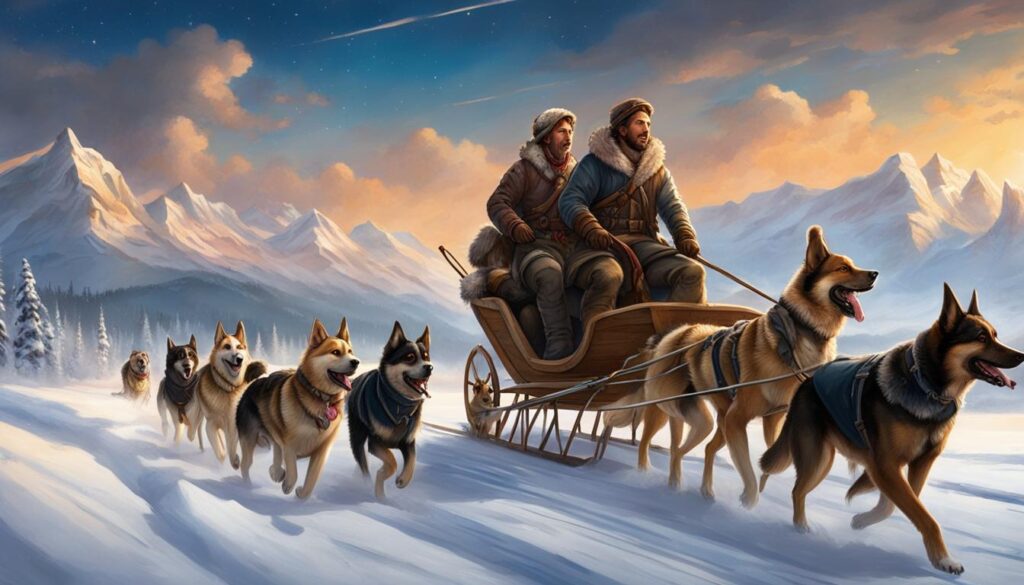
Dogs’ Adaptability to European Terrains
Throughout ancient European exploration, dogs displayed remarkable adaptability, thriving in diverse terrains and landscapes. These canine companions had the innate ability to navigate through various European environments, contributing to the success of expeditions and the discovery of new lands. Whether traversing dense forests, rugged mountains, or icy tundras, dogs proved to be resilient and agile companions, adapting effortlessly to the challenges posed by each unique terrain.
With their acute senses and instinctive knowledge of the natural world, dogs played a vital role in navigating European terrains. They skillfully guided explorers through uncharted territories, utilizing their keen sense of smell and hearing to anticipate potential dangers and obstacles. From the rocky coastlines of Scandinavia to the vast plains of Eastern Europe, these loyal canines led the way, ensuring the safety and progress of European expeditions.
In addition to their navigational prowess, dogs’ physical attributes allowed them to thrive in European landscapes. Whether it was their thick coats for warmth in colder climates or their sturdy paws for traversing uneven terrains, these adaptable companions were well-suited for the challenges encountered during exploration. Their endurance and agility facilitated the crossing of treacherous mountains, dense forests, and harsh terrains, making them indispensable companions on European expeditions.
The Resilient Canines of European Exploration
“The dog was created especially for children. He is the god of frolic.” – Henry Ward Beecher
Their adaptability, loyalty, and physical prowess made dogs valuable assets, enabling European explorers to navigate and conquer the vast and diverse terrains of the continent. These canines’ remarkable ability to thrive in European landscapes, alongside their unwavering loyalty and companionship, contributed significantly to the success of ancient European exploration.
As we delve deeper into the historical role of dogs in European exploration, it becomes evident that their adaptability and companionship were crucial not only to the adventurers themselves but also to the cultural and historical significance of these journeys. Through their resilience and unwavering loyalty, dogs left an indelible mark on the annals of European history, forever intertwined with the tales of exploration and discovery.
| Dogs’ Adaptability to European Environments | Canine Companions Navigating European Terrains | Dogs Thriving in European Landscapes |
|---|---|---|
| With their remarkable adaptability, dogs thrived in various European terrains, from dense forests to snowy landscapes. | Dogs skillfully guided European explorers through uncharted territories, utilizing their acute senses and instinctive knowledge of the natural world. | The physical attributes of dogs, such as their thick coats and sturdy paws, allowed them to endure and traverse challenging European terrains. |
The Cultural and Historical Significance of Dogs in European Exploration
Dogs played an indispensable role in ancient European exploration, leaving a lasting cultural and historical impact. These loyal and dependable companions were not only valuable assets to European explorers but also symbols of loyalty and companionship in ancient European societies.
Throughout European voyages of discovery, dogs forged deep bonds with their human counterparts, providing comfort and companionship during long and arduous journeys. Their unwavering loyalty and presence brought solace to explorers facing the challenges of the unknown. These faithful canines became cherished companions, offering emotional support as well as practical assistance.
In addition to their companionship, dogs made significant contributions to European expeditions. They aided in hunting for food, guarding against potential dangers, and even served as sled dogs in colder regions. These versatile animals were crucial to the survival and success of European adventurers, enhancing their ability to navigate through unfamiliar territories.
“Dogs are not our whole life, but they make our lives whole.” – Roger Caras
The historical role of dogs in European voyages cannot be overstated. Their ability to adapt to the diverse landscapes of Europe allowed them to excel as navigators, thriving in forests, mountains, and even snowy landscapes. Dogs became an integral part of the European exploration narrative, leaving an indelible mark on the history and culture of the time.
| Aspect | Cultural Significance | Historical Role |
|---|---|---|
| Symbol of Loyalty | Dogs were revered as symbols of loyalty and companionship in ancient European societies. | Dogs’ loyalty played a vital role in the success of European expeditions, fostering trust between explorers and their four-legged companions. |
| Companionship | Dogs provided emotional support and companionship to European explorers during their arduous journeys. | The presence of dogs brought comfort and solace to explorers, alleviating the hardships they faced on their expeditions. |
| Practical Contributions | Dogs aided in hunting, guarding, and serving as sled dogs, enhancing the survival and success of European adventurers. | Their practical contributions made them indispensable assets, enabling explorers to navigate through uncharted territories. |
Conclusion
In conclusion, dogs played a vital role in the exploration of ancient Europe. As loyal companions and trusted guides, these canines contributed to the success and safety of European expeditions. Their adaptability to different terrains and their innate sense of loyalty made them indispensable assets to European adventurers.
Not only did dogs assist in navigating uncharted waters and unpredictable landscapes, but they also provided comfort and companionship to the explorers. During long and arduous journeys, the presence of these faithful companions brought solace and helped alleviate the hardships faced by European explorers.
The cultural and historical significance of dogs in European exploration cannot be understated. These canines were esteemed members of ancient European societies, symbolizing loyalty and companionship. They left an indelible mark on the history and culture of the time, becoming an integral part of the European exploration narrative.
In summary, dogs in ancient European exploration were more than just working animals; they were invaluable partners and trusted allies. Their contributions, adaptability, and unwavering loyalty made them a crucial element in the quest to discover and explore new lands. The legacy of dogs in European exploration serves as a testament to the profound bond between humans and canines throughout history.
FAQ
Did dogs really play a significant role in ancient European exploration?
Yes, dogs were essential companions and valuable assets to European explorers during their journeys of discovery.
Were dogs domesticated before the first migrations to the Americas?
Recent scientific studies suggest that dogs were domesticated before humans migrated to the Americas, and they have a close connection to ancient human history.
How did dogs contribute to European exploration?
Dogs accompanied European sailors on their voyages, serving as trusted navigators and providing guidance in uncharted waters.
Were dogs just working animals in European exploration?
No, dogs were beloved companions to the European explorers, providing comfort and companionship during their long and challenging journeys.
What were some of the ways dogs assisted in European expeditions?
Dogs helped in hunting for food, guarding against dangers, and even served as sled dogs in colder regions, enhancing the survival chances of European adventurers.
How did dogs adapt to the different terrains in Europe?
Dogs showcased remarkable adaptability, excelling in navigating through dense forests and snowy landscapes, making them well-suited for the challenges posed by European landscapes.
What was the cultural and historical significance of dogs in European exploration?
Dogs were esteemed members of ancient European societies, valued not only for their practical contributions but also as symbols of loyalty and companionship.
Can you provide a summary of the role of dogs in European exploration?
Dogs played a crucial role as loyal companions, guides, and valuable assets to European explorers, leaving an enduring legacy in the history and culture of the time.

